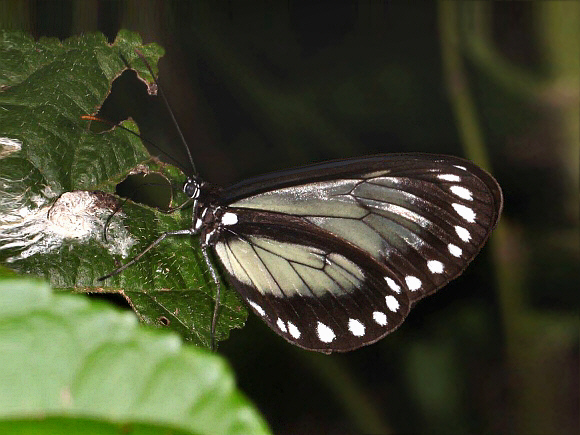
Introduction
The Ithomiini comprises of 376 known species, although it is likely that at least another 30 will be discovered in the near future. All are confined to the neotropical region. Ithomiines are unpalatable to birds, and are consequently mimicked in appearance by many other species. These include other unpalatable species ( Müllerian mimics ), not only from the Ithomiinae but also from several other butterfly families. There are also a large number of edible species ( Batesian mimics ) which have evolved similar patterns. Birds have the ability to memorise butterfly patterns and so learn to avoid eating noxious species, but are also fooled into ignoring similarly marked edible species.
Ithomiines are characterised by having small eyes, slender abdomens and long drooping antennae that lack distinct clubs. Males have a plume of long androconial scales or “hair pencils” on the costa of their hindwings. These are hidden from view when the butterflies are at rest, but are displayed when the wings are held open during courtship. Other Ithomiine characteristics include a very slow and deep wing beat, and a preference for inhabiting the darkest recesses of the forest understorey.
There are basically 2 types of Ithomiine. The first type are the black and orange-banded “tigers”, many of which are mimicked by other species due to their unpalatability to birds. The second type are the “glasswings”, recognised by their translucent wings and prominent venation. Many genera contain examples of both types, and in some cases an individual species may produce adults of both forms according to location.
The genus Hyalyris comprises of 13 species, which can be recognised by their distinctive venation, and by the broad black margins with which are prominent white submarginal spots. Some species have simple patterns like that of latilimbata, antea and mestra; but others including excelsa, coeno, schlingeri and oulita have conspicuous orange patches on the hindwings.
Hyalyris latilimbata is endemic to Peru.
Habitats
This species is found in mid elevation cloudforest on the eastern Andes, at altitudes between about 500-1800m. It can be found flying along shady forest trails, or in full sunshine along forest edges.
Lifecycle
To be completed.
Adult behaviour
Hyalyris latilimbata is usually seen singly on forest trails, feeding at bird droppings or at the flowers of Eupatorium. It sequesters pyrrolizidine alkaloids from these sources, which confer toxic qualities to the butterfly, thus which deterring bird attacks. The chemicals are also used in the production of pheromones used to entice females into copulation.
